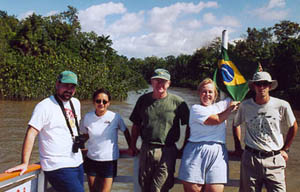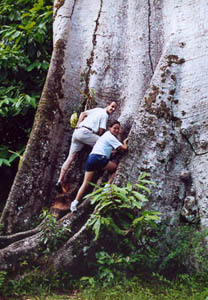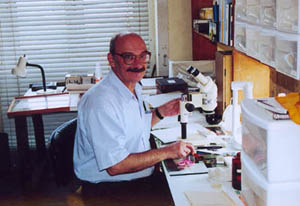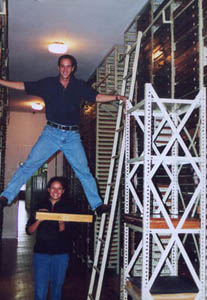
. |
.
Team
Scarab in Brazil
August 2000
Brett Ratcliffe and Mary Liz Jameson
|
| . |
Co-PIs
Brett Ratcliffe and Mary Liz Jameson and graduate students Andrew
Smith, Aura Paucar, and Federico Ocampo conducted research in the
major Brazilian entomology collections and attended the 21st International
Congress of Entomology in August 2000.
|
|
| . |
|
|
...... |
|
Following
in the footsteps of Henry Walter Bates, we first arrived in Belém
to begin our research. L-R, Andrew Smith, Aura Paucar, Brett Ratcliffe,
Mary Liz Jameson, Federico Ocampo. |
|
After
climbing several obstacles of Amazonian proportions, we finally
arrived at our destination. Fede and Aura
blazing a trail.
Photo by M. L. Jameson. |
.. |
|
|
| We
descended on our first collection, the Museu Paraense Emilio Goeldi
in Belém at the mouth of the Amazon River, where we curated
and identified the scarab collection for two days. Here, and at
all the museums, we gathered data from specimens for our various
scarab projects. Bento Mascarenhas (Head of Invertebrates) and Inocencio
Gorayeb (Tabanidae) coordinated our efforts in their collection. |
| .. |

|
|
.
.
.
.
.
.
Part
of Team Scarab at the Museu Goeldi. L-R, Aura, Fede, Andrew, Brett.
Photo by M. L. Jameson. |
..
|
| ___________________________________________________________________________________ |
| .. |
| After
the wonderful heat and humidity of Amazonia, we then traveled to
the Museu Naçional in Rio de Janeiro where we worked for
several days. Miguel Monné (Cerambycidae) was our contact
and gracious host. This collection is much larger and older, but
we were able to make good progress in sorting unidentified material,
curating, and providing identifications on many specimens. |
.. |
|
|
|
|
|
The
Museu Nacional in Rio resides in the old palace of the Portuguese
king, Dom Pedro. L-R, Brett, Andrew, Fede, Aura, Mary Liz. |
|
Brett
sorting cetoniines at the
Museu Nacional.
Photo by M. L. Jameson. |
.. |
|
.. |
|
|
|
Miguel
Monné, curator of the Coleoptera collections at the Museu
Naçional.
Photo by A. B. T. Smith.
.
.
. |
|
Brett,
Aura, Fede, and Andrew with Corcovado looming up behind. It was
winter in Rio so not many insects
on the vegetation. You can look
without a permit.
Photo by M. L. Jameson. |
.. |
|
|
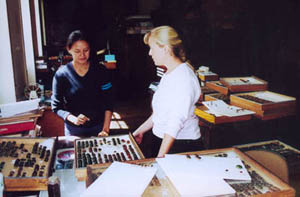 |
Mary
Liz with Rio's signature, Sugar Loaf,
in the background.
Photo by F. Ocampo.
. |
|
Aura
and Mary Liz curating the
large Rutelinae collection at the
Museu Nacional.
Photo by B. Ratcliffe. |
| |
| ___________________________________________________________________________________ |
| .. |
| Unfortunately,
we had to leave Rio (a beautiful city) to go to São Paulo
where we worked in the collections of the Museu da Zoologia of the
Universidade de São Paulo. These are the largest collections
in Brazil with a wealth of material. In addition to gathering data
for our studies, we sorted and identified over 50 drawers of specimens.
Ubirajara Martins (Cerambycidae) was our principal counterpart,
and a great deal of additional assistance was provided by Cleide
Costa (beetle larvae, retired), Sergio Ide (Scarabaeidae), and Fernando
Vaz de Mello (graduate student from the Universidade de Viçosa,
Scarabaeidae). John Lawrence (CSIRO, Australia), the world's expert
on the higher classification of Coleoptera, was conducting a workshop
at the Museum. He became an honorary member of Team Scarab in return
for letting us crash his coffee breaks for the course. |
| . |
|
|
|
Fede,
rising to the occasion, and Aura in
the scarab range at the Museu da
Zoologia in São Paulo.
Photo by M. L. Jameson. |
|
Ubirajara
Martins and Fede with one of Ubirajara's longhorn books.
Photo by M. L. Jameson.
. |
. |
|
|
|
|
|
Mary
Liz and John Lawrence with the requisite cup of cafezinha which,
when made in Brazil, does keep you awake.
Photo by B. Ratcliffe. |
|
Scarabaeidophiles
at the Museu da
Zoologia. L-R, Sergio Ide, Christiano
Lopes-Andrade, and Fernando Vaz de Mello.
Photo by M. L. Jameson. |
. |
|
|
|
|
|
|
Fede, Andrew, and Aura sorting and identifying scarabs in São
Paulo.
Photo by M. L. Jameson. |
|
Cleide Costa and Sergio Vanin, authors of Larvas de Coleoptera
do Brasil.
Photo by M. L. Jameson. |
| . |
| ___________________________________________________________________________________ |
| . |
After
Sao Paulo, we attended, along with about 4,000 other people,
the 21st International Congress of Entomology at Iguassu Falls
near the borders of Argentina and Paraguay. One of the highlights
of the meetings for us was the Scarab Symposium organized by
Brett Ratcliffe and co-moderated by Andrew Smith.
The speakers and their titles were:
1. Phylogenetic trends in the tribe Melolonthini in the Holarctic
Region: a biogeographical approach. Mila Coca-Abia, Museo Nacional
de Ciencias Naturales, Spain.
2. Systematics, ecology, and biogeography of Costa Rican dung
beetles. Angel Solís, INBio, and Bert Kohlmann, Escuela
Agric. Region Tropical Humeda, Costa Rica.
3. Distributional patterns of Amazonian dung beetles. Bruce Gill,
Canadian Food Inspection Agency, Canada.
4. Phylogeny of the Scarabaeoidea. Clarke Scholtz, University
of Pretoria, South Africa.
5. Hopliini of the Iberian Peninsula: a biogeographical and taxonomic
study. Eduardo Galante & Estefánia Mico, University
of Alicante, Spain.
6. Systematics and biogeography of Anoplognathini (Scarabaeidae:
Rutelinae), a tribe endemic to the Neotropical and Australian
realms. Andrew Smith, University of Nebraska, USA.
7. A preliminary overview of the Neotropical genus Epectinaspis
Blanchard (Scarabaeidae: Rutelinae: Anomalini). Aura Paucar, University
of Nebraska, USA.
8. Phylogenetic analysis of the Pelidnotina. Mary Liz Jameson,
University of Nebraska, USA.
9. Dung beetle communities in mountain systems. Jean-Pierre Lumaret
& Pierre Jay- Robert, Universite Paul Valery, France.
10. A synopsis of the New World Hybosoridae. Federico Ocampo,
University of Nebraska, USA.
11. Towards a molecular phylogeny of scarabaeid dung beetles.
A. Vogler, D.J.G. Inward, & C. Wilsher, The Natural History
Museum and Imperial College, UK.
12. A faunistic survey of the Dynastinae (Coleoptera: Scarabaeidae)
of Central America. B. C. Ratcliffe, University of Nebraska, USA. |
| . |
|
|
|
Iguassu
Falls from the Brazilian side.
Photo by M. L. Jameson.
.
.
.
.
. |
|
Scarab confab at the Congress. L-R, Angel Solís (Costa
Rica), Alberto Ballerio (Italy), Andrew Smith (U.S.A.), Rosalyn
and Jean-Pierre Lumaret (France), and Mary Liz Jameson (U.S.A.).
Photo by B. Ratcliffe (they all wanted him to back up just a little
more into the pool). |
| . |
| ___________________________________________________________________________________ |
| . |
After
Iguassu, the students returned to Nebraska because classes had
already begun. Brett and Mary Liz flew to Manaus in the center
of the Amazon basin to study the collections at the Instituto
Nacional de Pesquisas da Amazonia (INPA). This is the largest
on-site research collection in entomology for greater Amazonia.
Ricardo Andreazze provided invaluable assistance and helped to
sort material. |
| . |
|
|
|
Joachim
Adis and Brett at the Congress where they presented a paper on
dung beetles in the Amazonian Insects Symposium.
Photo by M. L. Jameson. |
|
Ricardo
Andreazze and Brett curating collections at INPA in Manaus.
Photo by M. L. Jameson. |
. |
|
|
A
final note . . .
.
At each museum we visited, we set aside specimens that we would
like to receive on loan. However, with the implementation in June
2000 of the Brazilian federal government's Medida Provisoria 2.052
(protection of genetic resources), it appears that even loans
of scientific specimens from Brazil will not be permitted until
the new law is clarified. This is a very serious impediment to
scientific research that will impact both Brazilian and other
scientists. At a time of an accelerating global biodiversity crisis,
especially in the tropics, it seems unthinkable that any government
would stop the sharing of scientific data that might help us to
better understand the threats to our biota. Before governments
or the scientific community can fully address such complex issues,
we first need to know the composition of the plants and animals
that live on Earth. Regulations such as MP 2.052 severely curtail
this knowledge. |
| . |
|
|
|
|
You
know its bad when I can't even get a permit to export bugs from
Brazil!
Heavenly photo by M. L. Jameson. |
.
|
|
|



